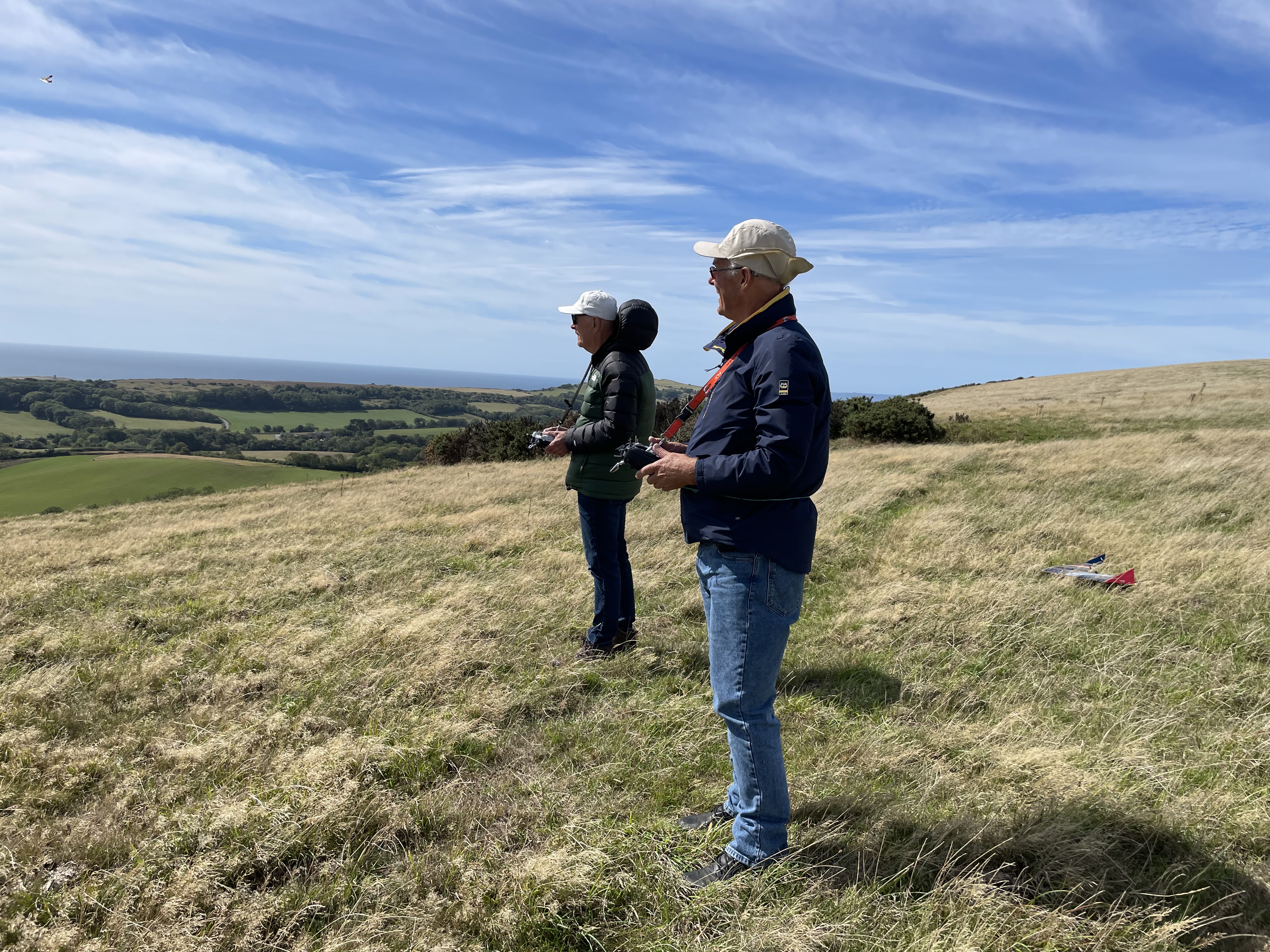SLOPING OFF...
...the Newsletter of Christchurch and District Model Flying Club for...December 2025
BOOMERANG XL Gas Turbine Jet
an unexpected journey, by Richard Docketty (and the other two Amigos)
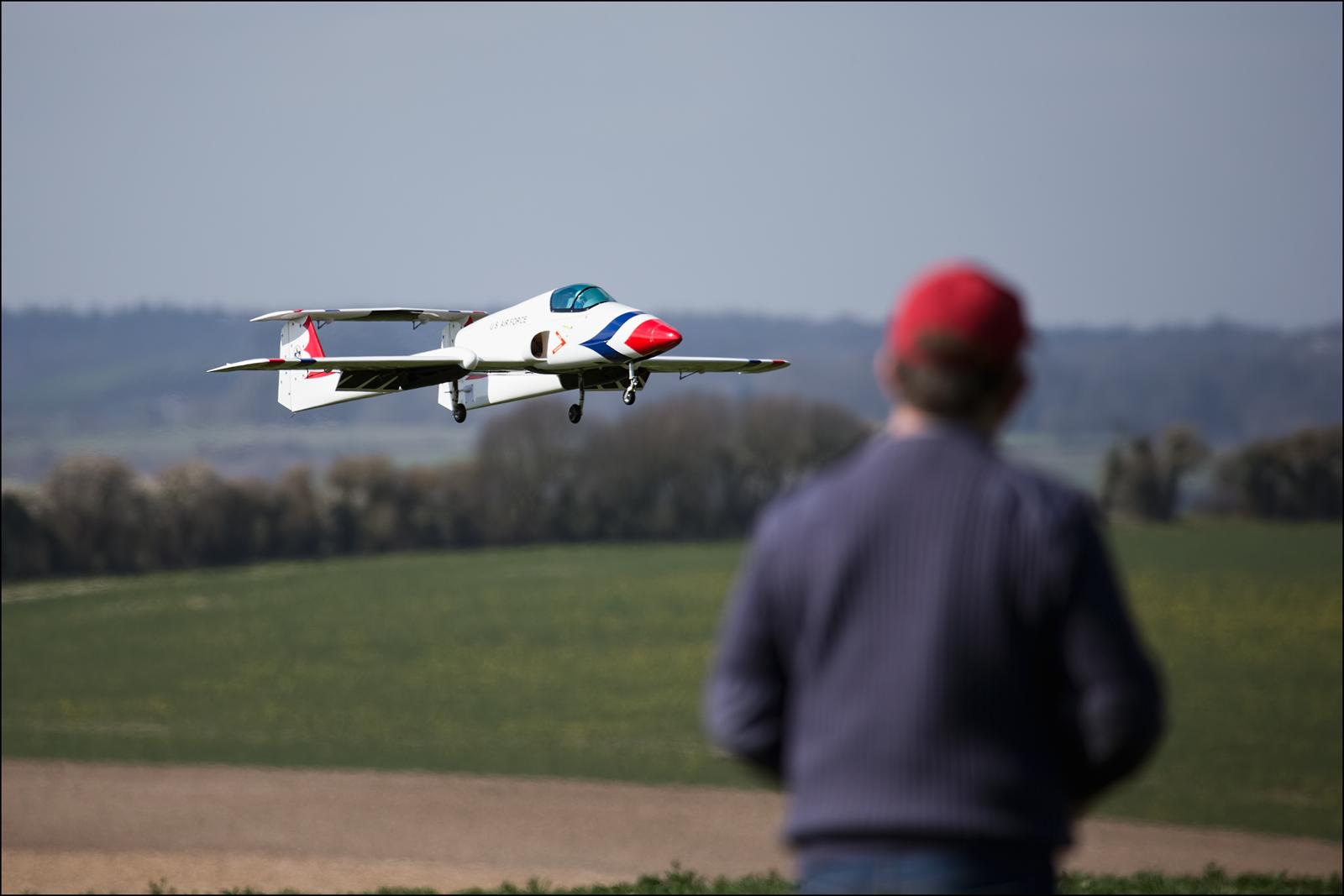
Our Friend, Ian Wickins, flying his Boomerang XL at County MFC
Yvonne and I were having breakfast one morning in early July 25 when Chris Wickins phoned to say her husband, Ian, had died in hospital from a heart attack the previous evening. We had known Ian and Chris for many years, and he was always a bit of a ‘Peter Pan’ character, so the news of his death was a complete shock to us. We just sat there, stunned. So many memories came flooding back.

Ian and I met on a falconry course in about 1988. Our friendship grew when we both acquired Red Tailed hawks then trained and flew them together over the North Downs near Guildford. Many happy memories of those times, hours hawking across open downs then trudging through the snow back to his small holding near Compton for some hot soup prepared by his partner, Chris. Ian, ever the joker, taught my two young boys (10 and 11 at the time) such things as how to turn dried cow pats into frizbees or how to modify party poppers by replacing the contents! They got such an education with Ian. Yvonne and Chris were good friends too and we were witnesses at their wedding, but sadly our trips to Compton came to an end when Ian and Chris moved to Witham Friary, near Frome. But we stayed in touch and met up regularly over the years, either to Somerset or our home in Surrey. It was one of those friendships where the length of time between get togethers didn’t matter. In later years Ian got into flying model gliders with the Whitesheet club. He also enjoyed flying large IC power planes with a club in Wiltshire (which eventually became the County MFC when they moved to their current site in the Deverills. It was Ian, who gave me a reference to the club secretary which led to my being invited to join the club). Sadly, we only managed to get to fly together at County a few times as by then he had largely given up the sport for other pursuits such as travelling around Britain with Chris in his campervan.
In the months leading up to his passing, Ian had made the decision to part with the majority of his prized model aircraft and sold off the models that were in the best condition minus one. Amongst the remaining aircraft in his collection was the Boomerang XL gas turbine jet, which he regarded with particular fondness. This impressive jet remained in his workshop waiting for its next flight with Ian which never came.
Please can you help…
As a close friend and knowing I shared Ian’s love of flying model aircraft, Chris asked if I could look at clearing Ian’s workshop of his remaining aircraft and anything modelling related. The first to go were two medium scale gliders and a large ASW15b followed by a very large AGWagon tug with an equally large engine. Which left the Boomerang XL sitting in pride of place on its own stand, almost goading me to take it on!
At this point, I really had no interest in turbines other than as a spectator at airshows, considering them as something only those with extra deep pockets could indulge in and then only if their piloting abilities were up to it. But, I thought, I could always check it out to see if there was anything needing doing before advertising it for sale for Chris. So that is where my relationship with the Boomerang XL really began.
I know nothing about turbine jets, but I know a man who does.
As soon as I lifted off the large hatch, I was stunned at the amount of technology the fuselage contained. The Jetcat turbine itself, the ECU for the turbine, a large Nimh battery for the ECU and two smaller Lipos with a regulator for powering the avionics, a nine channel RX, flight control box, fuel tank, fuel pump, compressed air canisters in the nose for the pneumatic retracks and brakes, pipework for fuel and air etc, switching solenoids, valves, and gauges. all neatly laid out before me. Then there was all the support paraphernalia: propane gas canister, fire extinguisher, remote GSU (Ground Support Unit for interrogating the turbine), Fuel and fuel pump, an air pump for pressurizing the pneumatics.

I will not tell you what my first thought was, but my second was what on earth have I let myself in for!
I had promised to keep Ian’s old club, County MFC, informed about the funeral arrangements. This sparked a conversation with the club chairman, Jonathan Harris (an excellent pilot and also very experienced flier of turbines) about Ian’s models where we discussed the emerging plan to eventually offer the Boomerang for sale. It turned out Jonathan had knowledge of the Boomerang as he originally helped Ian some years ago with setting it up and the initial flights. He suggested as a starting point we should make sure the turbine was good. If it wasn’t, we would likely be dead in the water anyway. He must have seen the ‘rabbit in the headlights’ look on my face, smiled then very kindly offered to help get it back in the air. So, checking out the turbine and its support systems was the first priority, followed by other areas like avionics and landing gear. We agreed to meet up at Ian’s house near West Cranmore in Somerset and do the turbine test in front of his garage. I should have realised this was going to be something completely out of the ordinary for me when from the back of his car Jonathan produced a tank of fuel, a fuel pump, two sets of ear defenders, a bottle of propane gas and a fire extinguisher and some other items I didn’t immediately recognise!


I watched as his experienced hands checked out various things, I knew not what at the time, and then connected a box called a GSU to the ECU followed by a “yup, that’s all good” and advised the turbine only had 16hours recorded run time (they are good to 50hours apparently) followed by the words “we best start it up then…”. Before I could reply, Jonathan passed a pair of ear defenders to me, while he began the startup procedure. I did my best to follow what he was doing and why, but failed miserably (subsequent startups proved much easier to follow and understand).
With the fuel tank part filled and propane gas canister attached to the turbine, Jonathan commenced the startup procedure by powering up the ECU and receiver. The throttle stick and trim set to maximum while propane was injected into the turbine. A low sound like a blowlamp soon started which got progressively louder and joined by an equally loud turbine whine. The gas was turned off and the motor throttled back to an idle then back up to full power. Thank goodness for the ear defenders! The test ended with a big smile and thumbs up from Jonathan and me. Luckily none of the neighbours came out to complain about the noise! I suppose they were used to loud sounds coming from the steam locos at the nearby East Somerset Heritage Railway.
A post-test discussion concluded the Boomerang was worth saving if any other issues were manageable or relatively inexpensive to fix.
A last flight in memory of a good friend – a plan is formulated.
A three-way conversation between me, Jonathan, and my wife, Yvonne, lead to the idea of flying the Boomerang one last time. Primarily as something of an memorial flight to its owner, Ian. But also, to prove it airworthiness to any future owner when sold. Jonathan then floated the idea of me being the future owner!
A almost throwaway line from Jonathan stopped me in my tracks. It went something like this: ‘You should fly it Richard, Ian would be really pleased if he knew you had it and I’m sure Chris would like it too….’ my reply was just ‘erm’. Undeterred, Jonathan pressed on with his proposition. ‘They really are easy to fly, if you can fly a Riot you can fly one of these. Think of it as a fast trainer, only faster.’ He continued ‘I can buddy up with Ian’s JR tx for the first flight just in case….but you will be fine!’. A silent ‘gulp!’ is all I could manage. Yvonne backed up Jonathan’s idea and it got a thumbs up from Chris too, so that was that. The decision had been made.
Jonathan offered to help with advice on the turbine and the pneumatic systems while I agreed to sort out any other problems. It was at this point I thought some additional knowledgeable and practical assistance would be useful.
Would you like to fly a real jet? – The other Amigos are recruited
The choice was obvious, I needed to have a conversation with my good friends Peter Chaldecott and Trevor Hewson, otherwise known in the club as the Three Amigos. Between them there was a deep pool of knowledge and modelling experience which would prove invaluable for getting the Boomerang safely back to flying condition.
I knew Peter and Trevor were about to embark on a new joint build of a Dehavilland Dove following the success of their Slingsby T31 so it was possible their time to get involved in the Boomerang could be limited. However, it’s said ‘it doesn’t hurt to ask does it?’ so I did.
The discussion went something like this: ‘Would you like a chance to fly my friends Boomerang XL turbine jet?’ The answer from them both was an immediate ‘yes!’. It transpired they had both enjoyed flying a smaller version of a Boomerang some years ago. Second question was: ‘Great, would you be able to help me sort out any gremlins and get it flight ready?’. I am pleased to say the answer was again an immediate ‘Yes!’. Wonderful guys.
Hand in pocket and the Gremlins
Grem1 - One of the non-return valves for the pneumatic retracts leaked and needed replacing. A direct replacement proved difficult to source, so an inline valve was purchased instead. Unfortunately it took several weeks for it to be delivered and was quite awkward to fit, but eventually it was fitted ok.
Grem2 - The three original batteries (2 lipos for Avionics and 1 large Nimh for the ECU) were considered quite old and could not be trusted in a turbine powered plane. New ones were needed. The two smaller replacement S2 Lipos were sourced from my own stock while the much larger Nimh was replaced with a S2 Lipo of a similar weight from Overlander, while maintaining the correct c.g.
With these known problems resolved, it was time to assemble the airframe. The Three Amigos convened one sunny afternoon on my driveway to put the Boomerang together to test the avionics and all the controls while we were at it. Once we had figured out what the correct build sequence was, the assembly was surprisingly simple. All the control surfaces worked correctly and deploying the flaps even engaged Crow braking – I later found this was a recommendation in the planes manual.
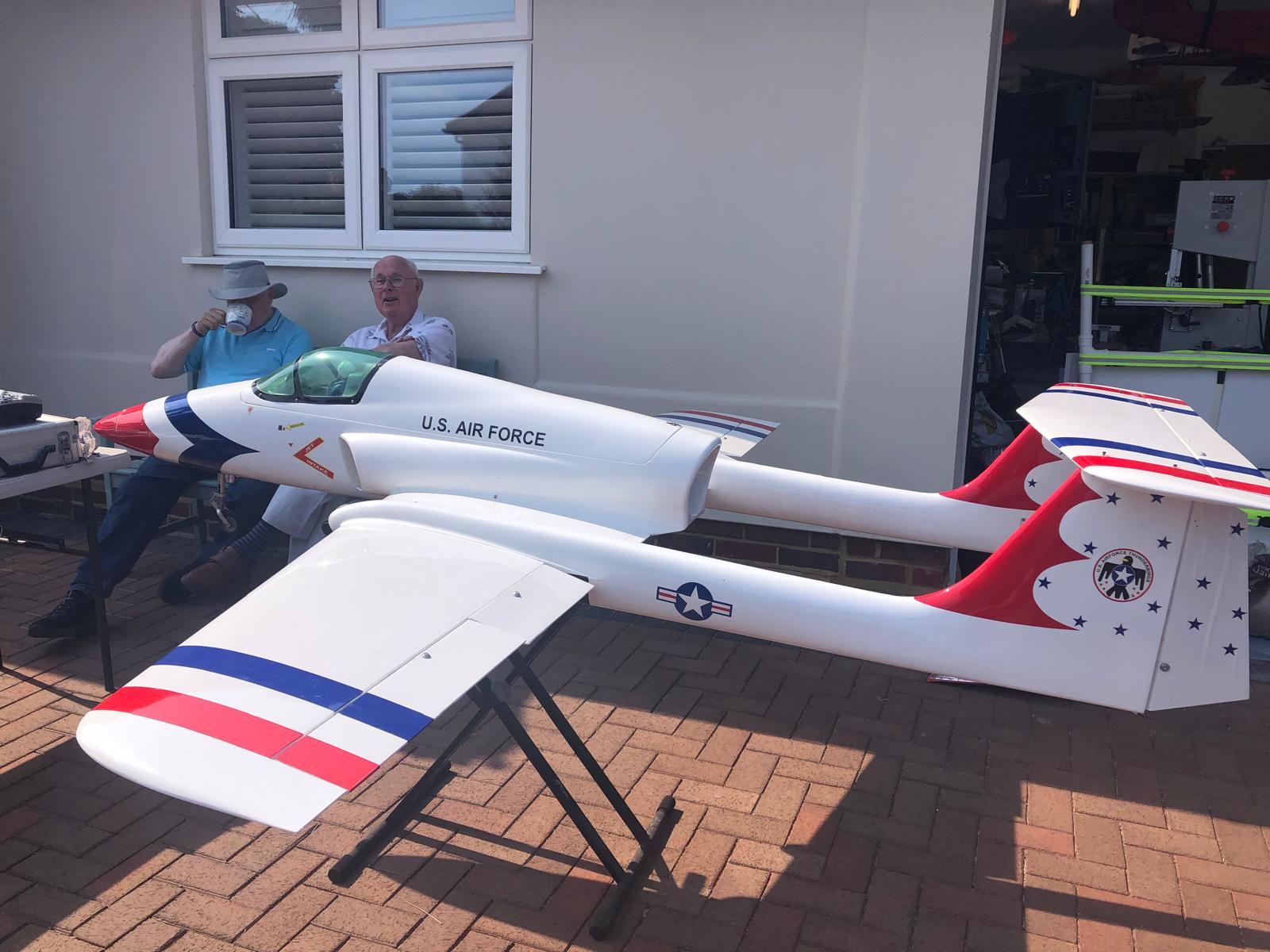
Trevor was keen to use the opportunity to test out the failsafe (very wise}. We didn’t have the wherewithal to fire up the turbine for the test, so a spare servo was plugged into the throttle channel on the RX instead to do the test which was successful.
Grem3 - It was while checking out the control throws the port rudder began juddering uncontrollably. Initial investigations centred around the servo being at fault and a replacement ‘hybrid’ servo from Trevor and Peters supplies was installed. All was ok to begin with, but this too started to misbehave. Extensive investigations continued with inconsistent results – sometimes all was ok, sometimes it would start misbehaving again. Although the wiring in the boom was replaced, the issue continued to recur sporadically. Checking the wiring and connectors from the rx out to the servo had drawn a blank, but then the problem just stopped happening. I hate faults like this. Talking it through with Trevor and Peter, the consensus was it was a connectivity problem which had been rectified during the physical investigations of the wiring loom. So problem solved, for now at least.
With the new valve fitted, the pneumatics could be pressurised and the retracts/brakes tested. The operation of the retracts was rapid and rather ‘binary’ and clunky compared to the slower controlled deployment of electric retracts we are used to. They were either up or they were down, no in between, but they did work fine. It took a little while to figure out how to engage the brakes. It turned out they came on when deploying full down elevator. More of that later.
As is the way of things, after spending many hours and some elapsed weeks working on the Boomerang, suddenly there is nothing left to do. It’s ready!
Memorial test flight and a slight scheduling issue.
It was time to choose a day with good weather when all three Amigos, our test pilot Jonathan, and our photographer Yvonne were available. Sounds easy enough doesn’t it. It wasn’t.
By now it was mid September and the long sunny days we had all enjoyed had become more sporadic. It took weeks to nail down a day when the weather was at least ok and we had a ‘thumbs up’ from everybody. Even then, pencilled in dates had to be moved for one reason or another. Eventually we had a window of opportunity, not quite a day with blue cloudless skies we were hoping for, but it at least it was dry and everything else was good to go.
Boomerang XL ‘Posse’ descend on County MFC
The date: 10th October 2025
Venue: County MFC, the Deverills, Wiltshire
Turbine expert and Tutor: Jonathan Harris
Safety officer: Trevor Hewson
Photographer: Yvonne Docketty
Ground Crew: Jonathan Harris, Richard Docketty, Peter Chaldecott
Pilots: Jonathan Harris, Trevor Hewson, Peter Chaldecott, Richard Docketty
Catering: Richard Docketty, Trevor Hewson
The Memorial flights, a bit of a flutter and some lolly sticks
The big day finally arrived, mild, a bit overcast, dry with medium strength winds from a westerly direction. It was a bit of an odd time to be honest, as the nervous feeling I had in the run up to this day had somehow been converted into one of excitement and I couldn’t wait to get going. The Boomerang, and its associate paraphernalia, was loaded in the car (along with my Marlin EDF, just in case things didn’t go according to plan) and off we set to County.
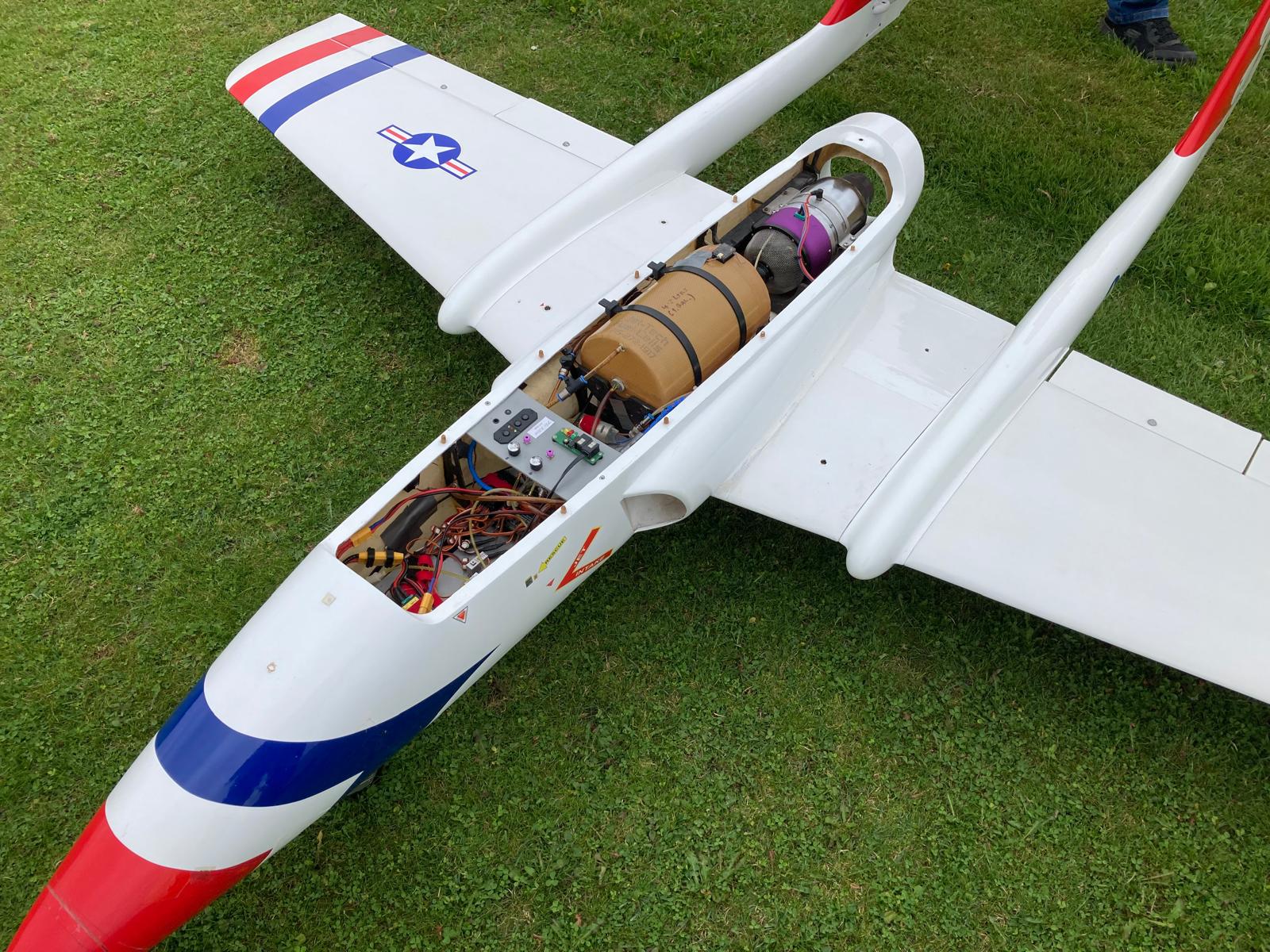
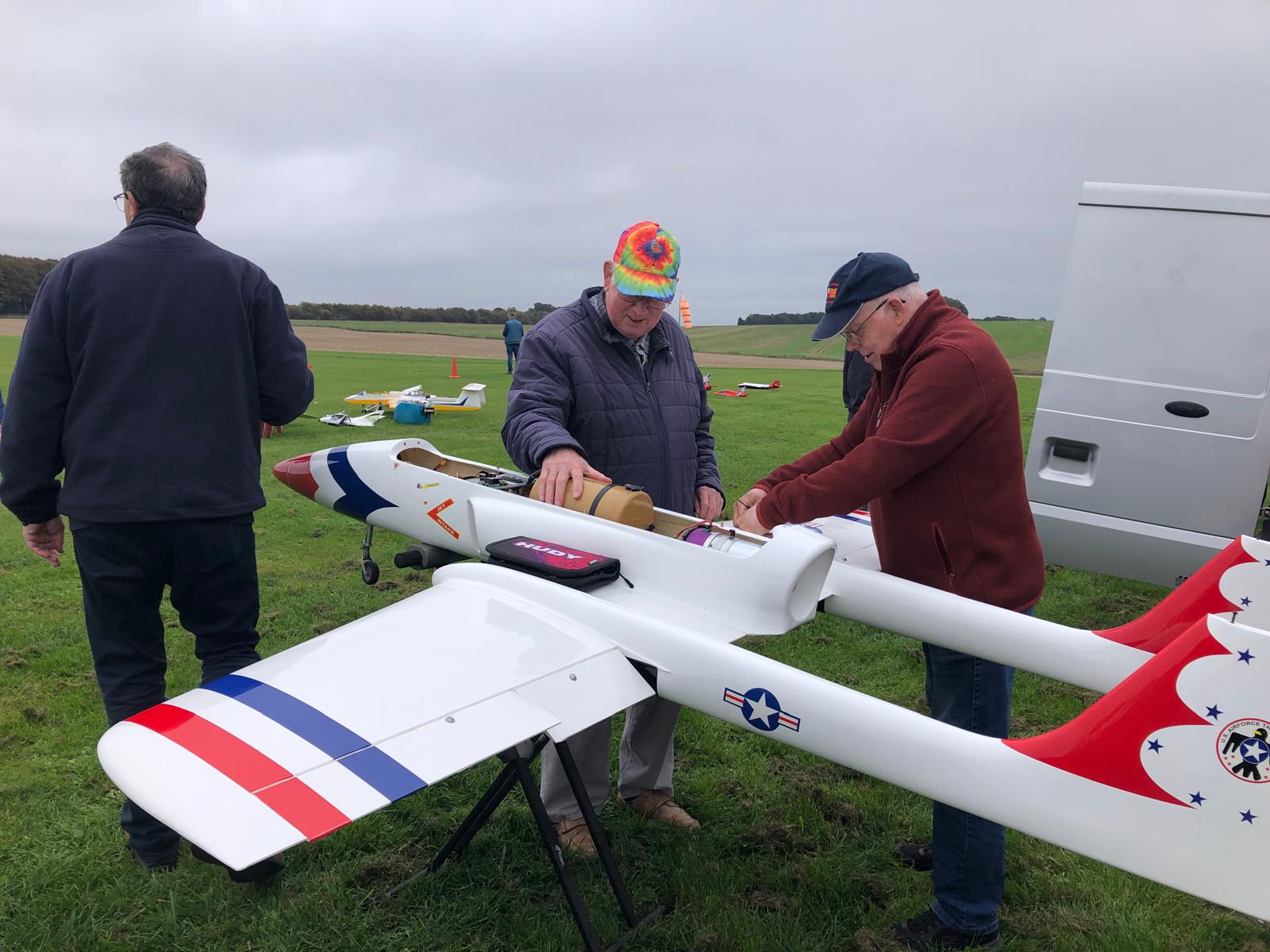
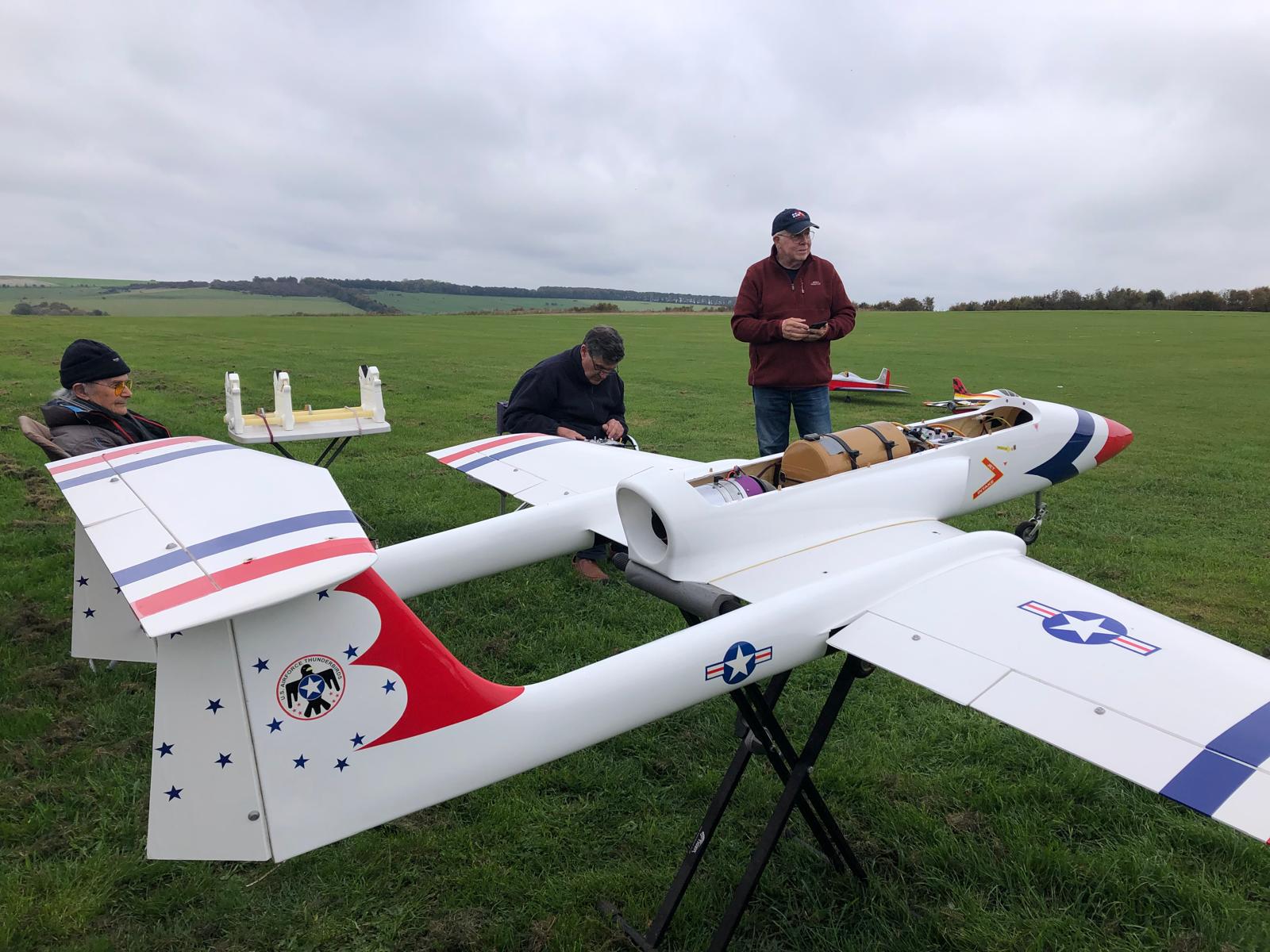
Peter and I had agreed to meet up with Jonathan at the flying ground around mid-morning to put the Boomerang together and check out its systems one last time ready for when Trevor (our designated safety officer for the day) joined us a little later to complete the pre flight safety checks and observe the turbine start. The radio system was checked: controls, failsafe, throttle cut, range check etc all came back good, so with the pneumatics pressurised, Jonathan filled the fuel tank (there was a slight issue during the fill when it was found the valve on the breather tube was still shut, causing unwanted pressure to build in the tank) and began the turbine start-up which went without a hitch. The Turbine spun into life and sent a blast of hot air in the direction of where Yvonne was sitting under a blanket shielding from the chilly breeze. She seemed to appreciate the warmth of the air heading toward her, though she was less fond of the smell of exhaust kerosene that came with it.
After we had a brief discussion with Jonathan regarding buddy controls and the concept of turbine lag, preparations for the first flight commenced.
I had decided, as the least experienced pilot there, I should go last in case of any ‘mishaps’ curtailed further flights. I realised Jonathan had probably been reading my thoughts when he handed the transmitter to Trevor! A significant increase in noise from the back of the Boomerang signalled its slow and purposeful taxiing onto the patch, followed by the four pilots to the flight line.
Jonathan did the first launch and initial trimming circuit before handing the control to Trevor. Peter and I stood behind Trevor, so unable to see his face, but quite certain he was smiling. See his flight review below.
It was soon Peter’s turn to fly and another smiling face conducted a fine controlled flight.
Lastly it was my turn on the sticks. No aerobatics from me, just scale-like manoeuvres (at least I hope that’s what they looked like to anyone watching). At no stage did I feel the boomerang was in danger of getting away from me. This really was a very nice plane to fly, clearly adding weight to the old adage that ‘size matters’ or ‘bigger the better’.It’s worth noting, apart from the first landing, not once did Jonathan have to assist during any of the flights as the plane was so stable and docile, as long as you kept an eye on the speed. There was also time to learn more about managing turbine lag. All too quickly we had used up our eight minutes flight time so Jonathan landed the plane and it was back to the pits to refuel ready for further flights and to have some lunch.
A celebratory break for lunch consisting of hot M&S pasties supplied by Trevor and his onsite/in car airfrier and desert in the form of tray bake brownies supplied by me. Smiles all around as we chatted about how well the first flights had gone and how keen we were to fly again.
Second flying session
With the Boomerang recharged with a fresh tank of fuel, the startup procedure was repeated with Jonathan handing me the transmitter to show me how to control this phase. The flying order remained unchanged: first Trevor, then Peter, followed by me. This time, however, Trevor handled both the take-off and flight. More aerobatics this time, all very smooth and controlled. You could tell Trevor was enjoying himself. Then someone said ‘what was that?’ something had detached itself from the plane and was floating down to earth so I went to retrieve whatever it was while Trevor’s flight continued. It turned out to be a large section of covering from one of the wing panels. Before I was able to return to the flightline, Trevor had handed over to Peter who then completed his flight, so Trevor had resumed control again, preparing to land with Jonathan providing guidance on managing the turbine lag. Following a nice touchdown it looked like it might overrun the patch so Trevor applied the brakes by introducing down elevator, the combined forces of each resulting in the nose gear collapsing. Jonathan and I retrieved the Boomerang with the whole nose wheel assembly just hanging down under the plane. Flying was clearly over for the day.
Initial inspection suggested a catastrophic failure of the nose gear support assembly, while the actual nose gear mechanism appeared not to be damaged. Closer inspection shocked all of us as clearly there had been damage repairs made in the past and ‘bodged’ with the use of wire, epoxy putty, random bits of wood including lolly sticks – yes, lolly sticks! (but these were no ordinary lolly sticks, these were Lidl lolly sticks!). When this was reported to Ian’s wife Chris, her response was simply ‘not surprised, I always called him Mr bodge it!’.
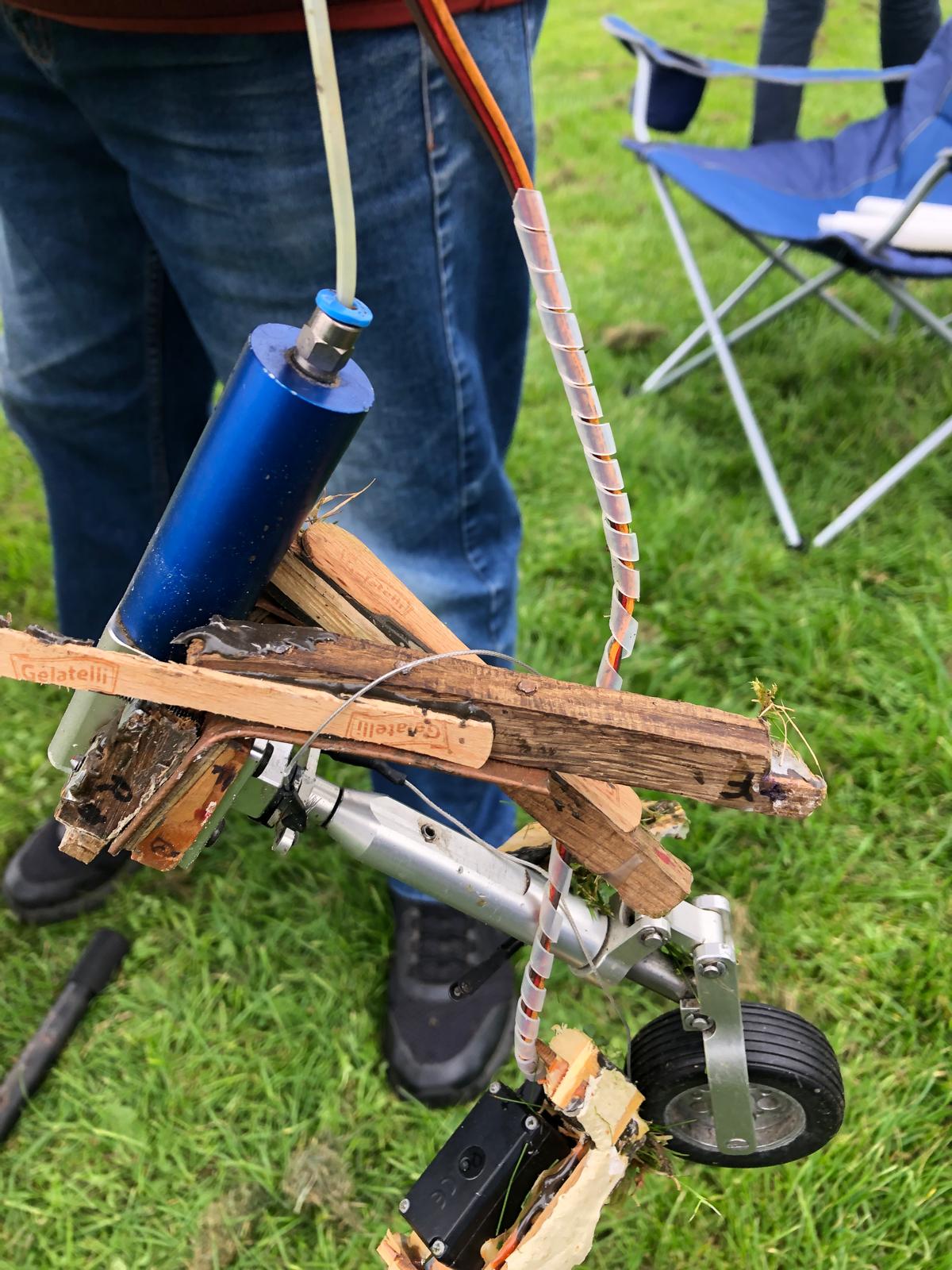
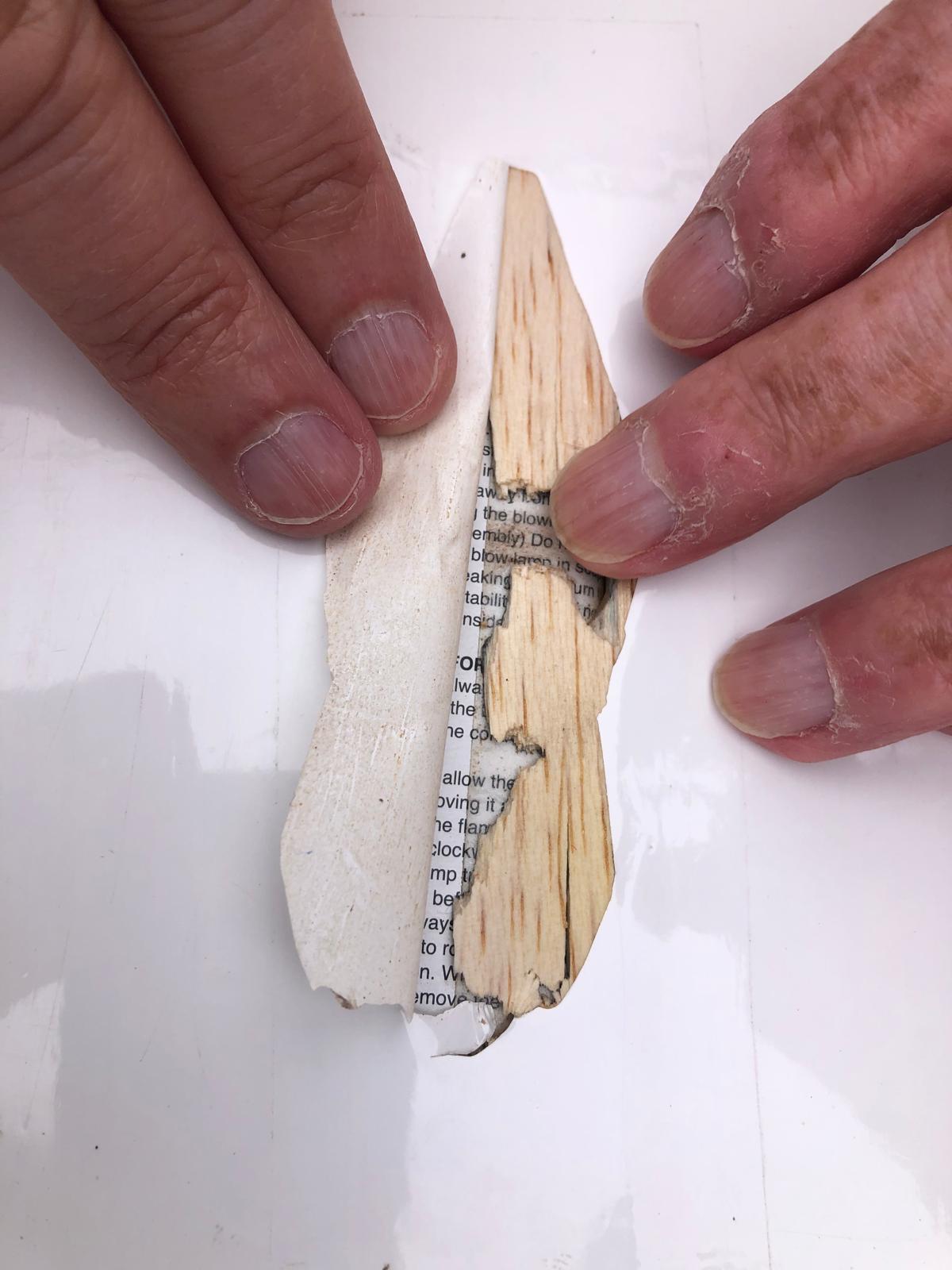
The Amigos and Jonathan debated whether to fix or scrap the Boomerang, and sell its turbine and parts for Chris. Peter felt the plane could be repaired and properly this time. It was definitely worth saving so we could fly it again. Given his exceptional skills in building and repairing models, Trevor and I readily agreed with Peters analysis.
The Boomerang fuselage now resides in Peter’s workshop while undergoing extensive and restorative surgery to its nose section, plus a bit of a tidy up and further investigations to make sure there are no other issues lurking. I haven’t yet mentioned the piece of wing covering that detached itself during Trevors aerobatics. It turned out the covering leading edge had lifted enough for the air to get underneath and cause it to rip. This has now been expertly replaced by Trevor including a new ‘star and bar’ decal.
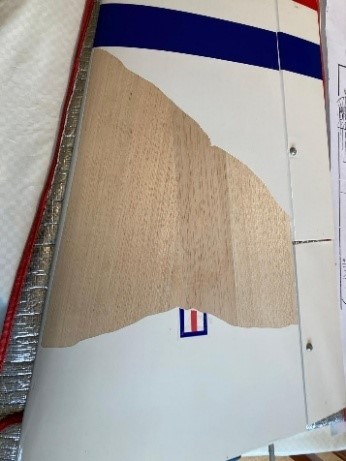

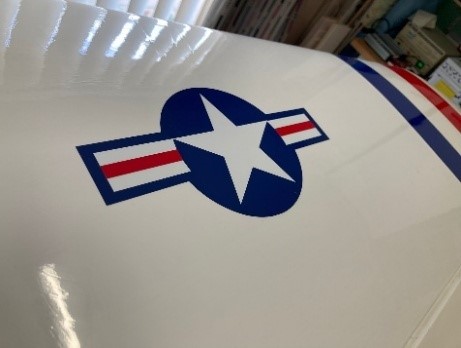
In summary.
This may seem like a disappointing, sad even, end to the days proceedings, but despite the problems and the need for repairs to be made, we were all quite upbeat. Everyone enjoyed themselves flying a turbine, sharing plenty of laughs and engaging in friendly banter along the way. A real team effort from all involved and a feeling this won’t be the last outing for the Boomerang or its new pilots. So, watch out for a possible second instalment in a future issue of Sloping Off covering the Boomerang’s return to full health and future maiden flights with its much stronger landing gear.
End of part one
Addendums:
Videos
Four videos were taken, (by Yvonne) on the day. .
https://youtu.be/BTx_EtEKIhU Taxi out. Peter dmonstrates the rather nervous feeling before any first flight
https://youtu.be/renWsJxsbCY Trevor takes off on the buddy lead with Jonathan
https://youtu.be/BsSDDgw7A2Y Trevor (I think) lands the beast. You can hear Jonathan’s advice on when to start the turn and when to throttle back. And “Try not to go off”!
Trevor’s Pilot Review on Flying the Boomerang XL
It was 20 years ago, almost to the very day, that Peter and I went to Swindon to attend a jet experience day at Paul Heckles’s flying school for what has been my only hands-on experience of a gas turbine model. On that day the model in question was a Baby Boomerang. Now, 20 years on, I was confronted by the imposing bulk of the XL version, and a formidable prospect it seemed!
However, there were two things that stuck in my mind from that earlier experience: Firstly, the aeroplane itself was very easy to fly, responsive but not twitchy (it is a jet trainer after all). Secondly the ‘turbo lag’ meant that you needed to give 2-3seconds notice of any required change in power setting. Not a problem when cruising around at half throttle but requires some thought in planning aerobatic manoeuvres.
So, as Jonathan led me by the buddy lead to the pilot box, I tried to reassure myself by that first memory and remind myself not to forget about the second one.
Under Jonathan’s control, the Boomerang took off without drama and, after a couple of trimming circuits, we checked that trim was still good on the trainer transmitter and before I knew it, the words “You have control” rang in my ears. A quick waggle of the ailerons confirmed that I was indeed in charge and I immediately began my first turn - you can’t pause to watch for a while with this model or it will disappear off into the distance. I flew a few circuits, getting a feel for the throttle response, then a loop, which was very nice, and a roll, which was fast! Then it was time to call Peter up for his first go, followed by Richard.
Re-fuelled and ready to go again, Jonathan this time entrusted me with the take off - something that didn’t happen 20 years ago!. This was uneventful, although the model did leap off the ground a bit more sharply than I expected - me being heavy handed on the elevator perhaps? or did the nose wheel hit a bump? Hang onto that thought.
This time I enjoyed a much more energetic and aerobatic flight but, on pulling through from a reversal, something large and white flew off the model. Handling seemed unaffected so the flight continued and while Richard went off to retrieve, I handed over to Peter for his turn.
Richard was still on his cross country walk by the time Peter was done and so Jonathan called me back and asked me to land it. Jonathan still had control of gear and flaps and we had a slight miscommunication on my first attempt, which at least proved that a go-around is possible as long as you decide in time to allow for the turbo lag! After a few words of clarification between us, I brought the model around again and in for what I thought was a pretty nice touch down. However, when I applied the wheel brakes, unfortunately the nose wheel collapsed. Remember that speculation about a bump on takeof? This brought proceedings to an end for the day.
My thanks to Jonathan, Richard and Peter for all the effort put into readying this model for the day and giving us such a memorable experience.
Update from Peter
I think Trevor has covered it very well and I don’t have much to add, other than “subsequent investigation of a previous repair (dare I say bodge) by a previous owner using Ice Lolly Sticks (!!!) exonerated Trevor from any blame concerning the Nosewheel collapse, and the fuselage now resides in my workshop awaiting a ‘proper’ repair, before we can once again enjoy the heady smell of Kerosene in our nostrils. Can’t wait!!!”
Watch This Space!
